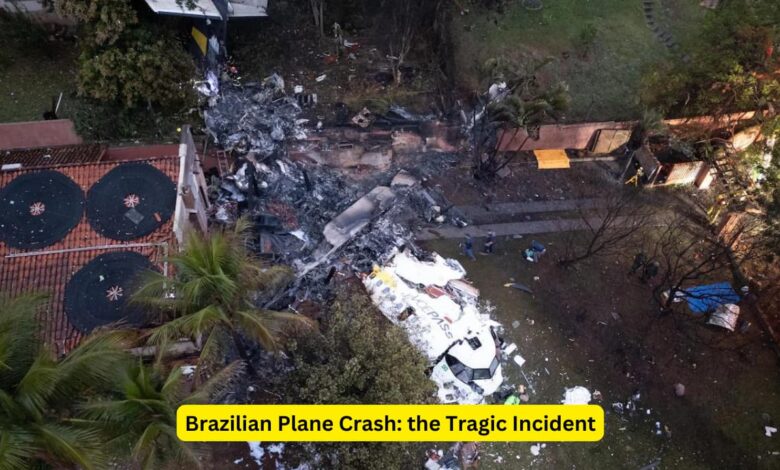Brazilian Plane Crash: the Tragic Incident

The Brazilian plane crash has become a poignant reminder of the risks associated with air travel, stirring widespread concern and attention across the globe. This tragic incident, which claimed numerous lives, has sparked questions about aviation safety, the circumstances leading up to the crash, and the broader implications for the industry. In this article, we will delve deep into the details surrounding the Brazilian plane crash, examining the key facts, potential causes, and the aftermath of this heartbreaking event.
Overview of the Brazilian Plane Crash
On the morning of August 10, 2024, a commercial aircraft bound for Rio de Janeiro tragically crashed shortly after takeoff. The flight, operated by a major Brazilian airline, was carrying 189 passengers and crew members. Within minutes of departure, the plane encountered severe technical difficulties, leading to a loss of control and an eventual crash in a densely populated urban area. Emergency response teams were quickly dispatched to the scene, but the impact was catastrophic, resulting in significant loss of life and widespread devastation.
Possible Causes of the Crash
Technical Malfunction
One of the primary areas of investigation has been the potential for a technical malfunction. Initial reports suggest that the plane experienced engine failure shortly after takeoff. Witnesses reported hearing unusual noises coming from the aircraft before it descended rapidly. The airline has confirmed that the plane underwent routine maintenance checks prior to the flight, but the exact cause of the malfunction remains under investigation. Aviation experts are examining the possibility of a mechanical defect, software issues, or even a failure in the plane’s hydraulic systems.
Human Error
Human error is another potential factor being considered. The Brazilian plane crash occurred during the critical phase of takeoff, a time when pilots must be highly alert and responsive to any anomalies. Investigators are reviewing the flight data recorder (FDR) and cockpit voice recorder (CVR) to determine if any errors in judgment or procedural lapses occurred. While the pilot and co-pilot were both highly experienced, the pressures of the situation and the rapid onset of technical issues may have contributed to the tragic outcome.
Weather Conditions
Though initial reports indicated clear weather at the time of takeoff, investigators have not ruled out the possibility that unforeseen weather conditions played a role in the crash. Sudden wind shear, turbulence, or microbursts can severely impact an aircraft’s stability, especially during takeoff and landing phases. The investigation will thoroughly analyze meteorological data to ascertain if weather conditions could have influenced the aircraft’s performance.
The Aftermath and Response
Emergency Response
The immediate aftermath of the Brazilian plane crash saw a swift response from emergency services. Firefighters, paramedics, and law enforcement arrived at the crash site within minutes, working tirelessly to rescue survivors and secure the area. Despite their efforts, the scene was one of devastation, with the wreckage scattered across a wide radius. The impact on the surrounding community was profound, with several buildings damaged and many residents displaced.
Support for Victims and Families
In the wake of the crash, there has been an outpouring of support for the victims and their families. The airline has set up crisis centers to provide counseling and assistance, and the Brazilian government has pledged to support the affected families. Vigils and memorials have been held across the country, honoring the lives lost in this tragedy. The incident has also prompted a nationwide discussion on aviation safety and the need for stringent oversight in the industry.
Aviation Safety and Regulatory Implications
Review of Aviation Protocols
The Brazilian plane crash has sparked a comprehensive review of aviation safety protocols in Brazil and beyond. Regulatory bodies are reassessing current safety standards, focusing on the maintenance practices, pilot training, and emergency preparedness of airlines. The incident has highlighted the need for continuous improvement in these areas to prevent future tragedies. Discussions are underway to enhance oversight and implement more rigorous safety checks for aircraft before flights.
Impact on the Aviation Industry
This tragic event has undoubtedly shaken the confidence of travelers and had a significant impact on the aviation industry. Airlines are facing increased scrutiny, and there is a growing demand for transparency in reporting maintenance records and safety measures. The industry must now work to rebuild trust with the public, emphasizing its commitment to safety and reliability. This incident serves as a stark reminder of the importance of vigilance and accountability in aviation.
Lessons Learned from the Tragedy
The Importance of Preparedness
The Brazilian plane crash underscores the critical importance of preparedness in aviation. Both airlines and regulatory bodies must ensure that all necessary measures are in place to prevent such disasters. This includes thorough maintenance checks, continuous pilot training, and updated safety protocols. The incident also highlights the need for effective emergency response plans, ensuring that teams are ready to act swiftly and efficiently in the event of a crisis.
The Human Factor in Aviation
While technology plays a significant role in modern aviation, the human factor remains crucial. The Brazilian plane crash serves as a poignant reminder of the pressures and challenges faced by pilots and crew members. Ongoing training and support for these professionals are essential to help them navigate difficult situations and make the best possible decisions under pressure.
Looking Forward: Enhancing Aviation Safety
Technological Advancements
In the aftermath of the Brazilian plane crash, there is a renewed focus on leveraging technology to enhance aviation safety. Advances in aircraft design, real-time monitoring systems, and predictive maintenance could help identify potential issues before they become critical. The integration of AI and machine learning in aviation could also provide valuable insights, improving decision-making processes and minimizing the risk of human error.
International Collaboration
Aviation is a global industry, and the response to this tragedy has underscored the importance of international collaboration. Sharing data, best practices, and safety innovations across borders is vital to enhancing overall aviation safety. The Brazilian plane crash serves as a catalyst for stronger cooperation between nations, fostering a unified approach to preventing future disasters.
Conclusion: A Tragedy with Lasting Impacts
The Brazilian plane crash is a heartbreaking event that has left a profound impact on the nation and the global aviation community. As investigations continue, it is crucial that the lessons learned from this tragedy are used to drive meaningful changes in aviation safety. By prioritizing preparedness, embracing technological advancements, and fostering international collaboration, we can work towards a future where such incidents are prevented, and the skies remain safe for all.




